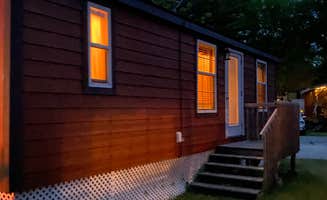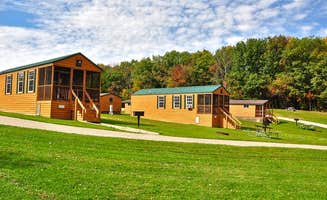Near Butler, Wisconsin, the glaciated landscape features diverse camping options across forest, prairie and lakeside environments at elevations between 800-1,000 feet. Spring and fall temperatures range from 40-65°F while summer averages 70-85°F with higher humidity levels. The camping season typically runs April through November, with most facilities closing water access during winter months.
What to do
Hiking on diverse terrain: At Ottawa Lake Campground in Kettle Moraine State Forest, trails accommodate various skill levels through glacial formations. "There are miles of nice hiking trails, a nice beach, pavilions to rent, horse riding trails, archery range and I'm sure I'm missing more," notes a camper at Menomonee Park.
Fishing from shore or boat: Multiple lakes provide year-round fishing opportunities within 30 miles of Butler. "The lake was incredibly clean. Scuppernong Springs was also a treat for the kiddos although I highly recommended planning for a solid 2 mile hike if you're with kids," shares a visitor to Ottawa Lake Campground.
Winter camping experiences: Several parks remain open year-round with modified services. "No showers in winter but awesome," comments a winter camper about Kettle Moraine State Forest. Seasonal activities include cross-country skiing on groomed trails from December through March when sufficient snow accumulates.
What campers like
Clean facilities with amenities: Basic amenities receive consistent positive mentions. "Bathhouse very nice. Very nice nature center. Laundry facilities available. Beach very nice," reports a visitor to Kohler-Andrae State Park.
Private wooded sites: Tree coverage varies significantly between campgrounds. "The sites are just about all wooded. Not huge but a good size for a country park. Most offer decent separation from your neighbor," notes a camper about Menomonee Park.
Proximity to water recreation: Many sites offer direct water access. "The quarry is good for swimming, kayaking, or canoeing. There is a beach with life guards," mentions a Menomonee Park visitor. Several locations feature swimming beaches with varying amenities from basic shore access to developed beaches with lifeguards during summer months.
What you should know
Reservation requirements: Most glamping facilities near Butler require advance bookings, particularly for premium accommodations. "We originally booked 96 but could not extend our slide because of large trees on either side of the pad and then the electric was about 50 feet away. Moved to 50 one of the nicest spots," advises a camper at Honeysuckle Hollow.
Noise considerations: Sites closer to roadways experience more ambient noise. "It was incredibly loud when we drove through the loop closest to the highway and was significantly better even just one section over," reports a visitor to Ottawa Lake Campground.
Seasonal changes in facility access: Water and shower facilities close seasonally at most locations. "The family sites are small and there is a main building down a steep hill to get to nicer facilities and showers," notes a camper at Naga-Waukee Park.
Tips for camping with families
Beach access considerations: Water quality varies throughout the season. "The lake is very clean and the site are a good size. Gets very busy on the weekends!" cautions a reviewer at Ottawa Lake Campground. For families with small children, weekday visits offer significantly less crowded beach access.
Insect preparation: Wooded sites require additional precautions. "DO NOT FORGET your bug spray the flies are huge. The upside of lots of bugs are lots of bird watching," recommends a visitor at Honeysuckle Hollow. Ticks remain active from April through November.
Playground proximity: Some sites offer better access to recreational facilities. "Fun park to ride bikes through. Many trails to walk or hike. The pond has a great beach for kids," shares a visitor to Naga-Waukee Park.
Tips from RVers
Electric hookup locations: Hookup positions vary significantly between sites. "These sites share an electric box. Some spaces the box is further than 30 feet from the pad," warns a camper at Honeysuckle Hollow. Extension cords rated for outdoor use are essential at many locations.
Site size considerations: Not all sites accommodate larger rigs. "Sites are not consistent, some very large and shaded and some smaller and crowded," notes a camper at Big Foot Beach State Park. Most parks provide site-specific dimensions on their reservation platforms.
Dump station timing: Peak season creates congestion at limited facilities. "The dump station was near the entrance to the camping loop and had potable water. It was also very busy and we had to wait when filling up and again when dumping," advises an RVer at Honeysuckle Hollow.




